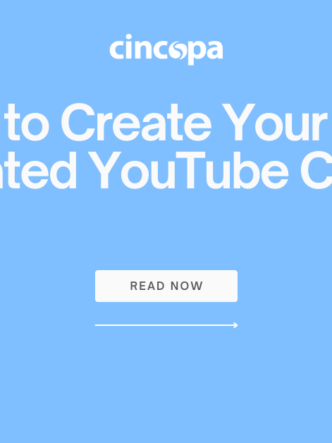Your videos need to be SEO optimized if you want them to rank well in the search engines. Metadata, such as titles, captions, descriptions, and tags, allows your videos to get indexed on all the major search engines with links back to your website. If you want your video content to improve your site ranking, you need to host it on your domain.
Host on your domain
If you upload your video on YouTube or elsewhere with a link back to your site in the description, it will expand your reach. However, search engines will crawl the YouTube video first which won’t help the ranking of your site in the search engines.
If you use Cincopa as your hosting platform, your video metadata is injected into the heading of your web page to direct traffic to your site. The embed code, JSON-LD, helps your content to rank higher and increases your traffic. Your web page load time decreases another vital SEO factor. A video is automated, so you have no extra work after you embed your video. All you must do is copy and paste the embed code.
How does JSON-LD work?
JSON-LD adds metadata from images embedded on a web page to its <head> section. By that, your content becomes better indexed by search engines. Cincopa allows you to specify metadata like caption, description, tags for each image; you also can create a unique meta description for image galleries or slideshows. All this information gets automatically included into embed code. Not only will search engines crawl your website and index your content faster, but also the web page load time will decrease, which is an important SEO factor as well.
Relevant metadata
Metadata offers more details about the title of the video, its description, length, and file name. These details help search engines to index it. According to Google, it sees the title, thumbnail, and description as most important.
A simple, relevant title: The name of your video is included in the structured data. Remember that the title should reflect the specific content of the video, not just replicate the title of the page where the video is embedded.
A compelling thumbnail: The thumbnail of a video catches the attention of viewers and is the first thing they notice when they’re scrolling through search results. Your thumbnail is somewhat like a movie poster – it’s a static advertisement for the video itself, and its job is to encourage people to click through and press play. It doesn’t have to be an actual frame from the video itself; it just must be an exciting and honest reflection of the contents of the video.
The Video Description: This may provide more details and keywords that can boost the ranking of your content.
Decide on a type of embed
With Cincopa you have the option of two basic types of embed: inline and popover. Google tends to index popover embeds far less often than the inline alternatives, and this is likely to be because popover embeds need to be clicked to trigger the JavaScript delivering the video.
When you’ve selected the embed type that’s best for you, make sure the box marked “SEO Metadata” is selected, which will ensure that structured data injects into the page where you embed the video. Inversely, if for whatever reason you don’t want your video indexed in search, unselect this box.
Avoid multiple videos on one page
Google typically indexes one video per page. If you include numerous videos on a page, it’s unlikely that the search engine crawlers will recognize and parse more than the first video. It may be a good idea to create a new page for each video as this makes indexing in Google easier.
Avoid funky JavaScript (unless you know what you’re doing)
The most common reason why video SEO fails to work is that Google can’t find or read the videos on your page. If you’re building entire sites with angular.js or using other JavaScript libraries to deliver page content, as opposed to just HTML and CSS, then the video can get buried under multiple layers of JS. This translates to Googlebot video never finding your video.
Quality comes first
There are many ways to upload your video or image content, but the quality has to be the starting point of your marketing strategy. You can apply all of the above tips, but your content has to engage viewers and offer them quality viewing. Once you have begun creating high quality, relevant content, you can apply SEO to make sure that your videos get noticed, both by viewers and the search engines.
Cincopa’s JSON-LD makes your website more popular in image search
Google and Bing provide a special search for images, where anyone can find a picture by certain keywords. Cincopa’s JSON-LD helps you to dramatically improve your SEO results and increase traffic by ranking your content higher in image search results. The more image content is added to your website, the more likely users will be able to discover it on the web.
The best way to add multiple images to a website is by embedding an image gallery or slideshow. Cincopa provides a great number of customizable gallery and slideshow templates that fit for any business needs. Simply pick a template that looks best to you, customize it in our intuitive gallery wizard, drag and drop your photos or pictures (or take advantage of other upload methods available), and you’re almost done! You only need to copy the embed code and paste it wherever you want the gallery to appear on your website.
JSON-LD dynamically injects metadata from images and galleries into website code, and it also associates your pictures with keywords from the text. For example, if you have a website about cooking recipes, animals, or home decor. Just add a beautiful image gallery according to the topic and fill in as many SEO fields as you can using relevant keywords. JSON-LD will use this data along with the text you have on a web page to boost your website in image search. When someone types a search query containing one of your keywords in Google or Bing image search, they will see pictures and photos from your galleries linked to your website among other search results.
So, if you create a gallery with multiple images, each one will appear in Google image search and give you more chances to get traffic.
After all, you needn’t be a coding guru to utilize the power of Cincopa’s JSON-LD embed code. Everything works just in a few clicks, so you can focus on producing great content and get amazing SEO results!














